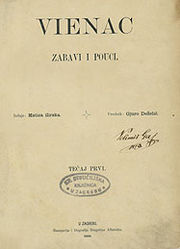
Vijenac
Encyclopedia
Vijenac is a biweekly magazine for literature, art and science, established in December 1993 and published by Matica hrvatska
, the central national cultural institution in Croatia
.
 The magazine is seen as the direct descendant of the Vienac literary magazine.
The magazine is seen as the direct descendant of the Vienac literary magazine.
Vienac was published by Matica hrvatska
, the central national cultural institution of Croatia
. It gathered the best Croatian writers and poets
of the second half of the 19th century. It was published from 1869 to 1903 and from 1993 till today.
It was created in 1869 to "delight and educate" (zabavi i pouci). Prominent cultural figures were editors-in-chief. In the first year, the magazine was managed by Đuro Deželić, then by Ivan Perkovac, Milivoj Dežman, Franjo Marković
and Vjekoslav Klaić
.
Vienac soon became the main Croatian literary magazine of the second half of the 19th century, especially when it was managed by the greatest Croatian writer of the time, August Šenoa
, from 1874 until his death in 1881. It is a showcase of the big literary names of the period. For example, Ksaver Šandor Gjalski
published his first short story there in 1884. Vijenac also published translations of works by Zola
, Daudet
and Turgenev. From 1890 to 1896, it was edited by Josip Pasarić, a major critic of Croatian realism
.
Both the content and the illustrations were on the level of the contemporary European literary magazines. Vienac was the only edition of Matica Ilirska (the Illyrian
Matica) until Matica was restructured in 1874. After that, it was published by a printing company. It died out in 1903.
Matica hrvatska
Matica hrvatska is one of the oldest Croatian cultural institutions, dating back to 1842. The name is somewhat idiosyncratic, best translated as "The Croatian Centre" . It is the largest publisher of Croatian language books...
, the central national cultural institution in Croatia
Croatia
Croatia , officially the Republic of Croatia , is a unitary democratic parliamentary republic in Europe at the crossroads of the Mitteleuropa, the Balkans, and the Mediterranean. Its capital and largest city is Zagreb. The country is divided into 20 counties and the city of Zagreb. Croatia covers ...
.
Historical background

Vienac was published by Matica hrvatska
Matica hrvatska
Matica hrvatska is one of the oldest Croatian cultural institutions, dating back to 1842. The name is somewhat idiosyncratic, best translated as "The Croatian Centre" . It is the largest publisher of Croatian language books...
, the central national cultural institution of Croatia
Croatia
Croatia , officially the Republic of Croatia , is a unitary democratic parliamentary republic in Europe at the crossroads of the Mitteleuropa, the Balkans, and the Mediterranean. Its capital and largest city is Zagreb. The country is divided into 20 counties and the city of Zagreb. Croatia covers ...
. It gathered the best Croatian writers and poets
Croatian literature
Croatian literature is a definition given to the compilation of novels, dramas, short stories, poems and other various work of written kind entirely attributed to the medieval and modern culture of the Croats and the Croatian language....
of the second half of the 19th century. It was published from 1869 to 1903 and from 1993 till today.
It was created in 1869 to "delight and educate" (zabavi i pouci). Prominent cultural figures were editors-in-chief. In the first year, the magazine was managed by Đuro Deželić, then by Ivan Perkovac, Milivoj Dežman, Franjo Marković
Franjo Markovic
Franjo Marković , was a Croatian philosopher and writer.He was an academician, the first professor of philosophy at the renovated University of Zagreb in 1874...
and Vjekoslav Klaić
Vjekoslav Klaic
Vjekoslav Klaić was a Croatian historian and writer, most famous for his monumental History of the Croats.Klaić was born in Garčin near Slavonski Brod as the son of a teacher. He was raised in German spirit and language, since his mother was German. Klaić went to school in Varaždin and Zagreb...
.
Vienac soon became the main Croatian literary magazine of the second half of the 19th century, especially when it was managed by the greatest Croatian writer of the time, August Šenoa
August Šenoa
August Šenoa was a Croatian novelist, critic, editor, poet, and dramatist....
, from 1874 until his death in 1881. It is a showcase of the big literary names of the period. For example, Ksaver Šandor Gjalski
Ksaver Šandor Gjalski
Ksaver Šandor Gjalski, or Ljubo Babić-Gjalski was a Croatian writer and civil servant....
published his first short story there in 1884. Vijenac also published translations of works by Zola
Zola
Zola may refer to:People:* Zola , South African entertainer* Émile Zola , French novelist* Arlette Zola, Swiss singer* Calvin Zola , Congo DR footballer...
, Daudet
Daudet
Daudet may refer to:* Alphonse Daudet, a French novelist*Léon Daudet, a French journalist, writer, an active Orléanist, and a member of the Académie Goncourt...
and Turgenev. From 1890 to 1896, it was edited by Josip Pasarić, a major critic of Croatian realism
Realism (arts)
Realism in the visual arts and literature refers to the general attempt to depict subjects "in accordance with secular, empirical rules", as they are considered to exist in third person objective reality, without embellishment or interpretation...
.
Both the content and the illustrations were on the level of the contemporary European literary magazines. Vienac was the only edition of Matica Ilirska (the Illyrian
Illyrian movement
The Illyrian movement , also Croatian national revival , was a cultural and political campaign with roots in the early modern period, and revived by a group of young Croatian intellectuals during the first half of 19th century, around the years of 1835–1849...
Matica) until Matica was restructured in 1874. After that, it was published by a printing company. It died out in 1903.

